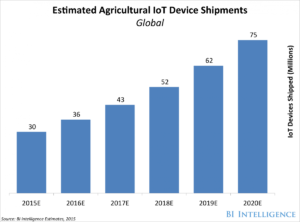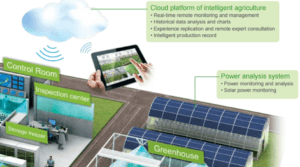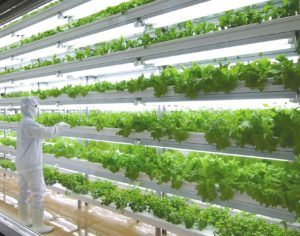Agricultural Intelligence: Innovative farm management technology helps combat climate change! A case study on Advantech’s IoT Smart Farming solution.

In 2050, the world will need to produce 70% more food than it did in 2006 to feed the growing population. To meet growing demand, agricultural companies have turned to the analytics and increased production capabilities the IoT can provide. On the other hand, with the mature development of Internet of Things (IoT) technology, the introduction of information and communication technology and automation control technology in farm management has become a recent trend. It is expected that installations of IoT devices for agricultural purposes will increase from 30 million this year to 75 million in 2020, representing a 20% CAGR.
In 2050, the world will need to produce 70% more food than it did in 2006 to feed the growing population. To meet growing demand, agricultural companies have turned to the analytics and increased production capabilities the IoT can provide. On the other hand, with the mature development of Internet of Things (IoT) technology, the introduction of information and communication technology and automation control technology in farm management has become a recent trend. It is expected that installations of IoT devices for agricultural purposes will increase from 30 million this year to 75 million in 2020, representing a 20% CAGR. [0]
The farming industry will become more important than ever before in the next few decades. According to the UN Food and Agriculture Organization, the world will need to produce 70% more food in 2050 than it did in 2006 in order to feed the growing population of the Earth [1]. To meet this demand, and to effectively overcome the impact of complex and volatile climate, the geographical limitation, natural disasters, pests and diseases, farmers and agricultural companies are turning to the Internet of Things for analytics and greater production capabilities and better yields. BI Intelligence predicts that IoT device installations in the agriculture world will increase from 30 million in 2015 to 75 million in 2020, for a compound annual growth rate of 20%. [2]
Per Business Insider, here are a few examples of IoT applications in agriculture.
- Sensors are being placed in soil to track current acidity levels, temperature, and other variables that, when known, help farmers increase their crop yields.
- John Deere is connecting its tractors and farming equipment to the internet and has built a platform to display analytics about farmers’ crop yields. In addition, it has pioneered self-driving tractors, which could replace farm workers.
- Drones and satellite imagery tools are being used to survey current farmland and generate data about their crops.
Advantech, the world’s biggest industrial computer company headquartered in Taiwan, has been working on smart farming for years. Here are two success cases, each for one major application: intelligent greenhouse and plant factory.
Internet of Things (IoT) solution for orchid greenhouse
Orchids need certain temperature and humidity conditions to grow and bloom, and their flowering time may not be exactly in line with market demand, so the price collapses when there is overproduction. In the past, most environmental control systems in orchid greenhouses in Taiwan could not be monitored and controlled because they were not connected to the cloud. By installing IoT control peripheral devices and software, we can ensure optimal planting conditions and better control thus minimize overproduction. [3]
Factory for plants? A plant factory with a year-round harvest
IT applications have changed agricultural production. Plant factories do not depend on the weather. Moreover, hydroponic vegetable plant monitoring systems successfully cultivate crops with high economic value. Through sensor integration, automatic control, information processing, and network communications capabilities, coupled with the cloud architecture, the system provides remote monitoring and factory automation management, saving significant labor for inspection and adjustment, providing suitable growth environment for the plant in a more energy efficient and cost-saving way. [3]
Going forward…opportunities and challenges
Artificial intelligence and internet of things technology can fill the current manpower shortage and change the face of agriculture by increasing efficiency, reducing production costs of vegetables and fruits, minimizing environmental impacts and harvesting more. We already see more robots, automatic control technology monitoring greenhouse environment equipment, controlling the crop cultivation conditions (temperature, sunlight, humidity, air circulation, pH, CO2, nutrient), and dedicated agriculture software and cloud management platform on the market place. In the near future, the solution can be extended to support environmental control, irrigation control, and even emergency treatment.
However, challenges remain to be that service costs and niche products are slowing adoption of the new technologies. Even though the benefits of IoT in agriculture include better yield rates and reductions in the amount of water, soil, and seed needed the worry is the implementation of IoT systems and cost of service surpasses the costs saved from using the technology. General worries about robots taking over people’s jobs are not helping with the technology adoption either. [4] Now agriculture industry is not seeing large profits and service providers need to be able to show their value if they want customers that send payment every year. If reduction in water usage or increase in yield rate is worth it, we are bound to see more of these IoT startups enter the market, but if it’s not, we might see farmers firmly reject these emerging technologies for a few more years. [5]
[0] Business Insider – the internet of things 2015 – how will iot affect the world
[1] UN Food and Agriculture Organization, http://www.un.org
[2] BI Intelligence Internet of things report 2016
[3] Advantech smart farming solution white pater
[4] Readwrite – humans robots agriculture swap http://readwrite.com/2016/07/06/humans-robots-agriculture-swap-it4/
[5] Readwrite – can iot end the world hunger http://readwrite.com/2016/06/07/can-arables-iot-device-end-world-hunger-vl1/
(789 words).








Thanks for the post, Bastiane. With growing demand for food and expected decreases in average crop yields due to climate change, it is important to think about ways that farmers can adapt their practices to meet future demand. While I was aware of ongoing research into GMOs, and biologicals that increase yields, I had not yet considered the impact that IoT technology might have on the agriculture industry.
I believe that the most effective solution will be one that combines different types of innovation. IoT technology alone will not be sufficient to feed the planet, but if IoT technology is researched in combination with new seeds that are better adapted to changing environments, the issue may be addressable.
Very interesting! There are many opportunities to optimize operations of agricultural practices by introducing technologies, I think the speed of implementing those technologies are often slower than other industries. Especially in Japan, as farmers are aging and an average age of them is reaching almost 70, the IT literacy maybe one hurdle besides the cost of implementation.
However, as IoT would significantly increase the efficiency of agricultural practices, I would love to learn more about this and promote the implementation in Japan in the future, really.
Thanks for this post! While I knew that population growth was outstripping food supply, I had no idea that the world will need to produce 70% in 2050 to fulfill demand. Especially as the ramifications of climate change continue to impact agricultural production, I expect that this demand will be even harder to fill. It was very interesting to read about the potential of IoT; I would love to learn about more of the IoT start ups that are in early stage development. I wonder if there is a way to incentivize more farmers to utilize the new technologies, like the way that homeowners are provided tax breaks by installing solar panels or by buying electric cars. Perhaps this way, farmers will be less worried about technology taking their jobs and instead willing to work towards more sustainable and environmentally-friendly states.